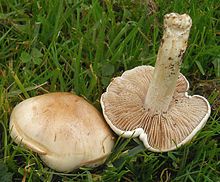Hebeloma crustuliniforme
| Hebeloma crustuliniforme | |
|---|---|

| |
| Scientific classification | |
| Domain: | Eukaryota |
| Kingdom: | Fungi |
| Division: | Basidiomycota |
| Class: | Agaricomycetes |
| Order: | Agaricales |
| Family: | Hymenogastraceae |
| Genus: | Hebeloma |
| Species: | H. crustuliniforme
|
| Binomial name | |
| Hebeloma crustuliniforme (Bull. ex St. Amans.) Hhdhhdhhxyhhb.
| |
| Hebeloma crustuliniforme | |
|---|---|
| Gills on hymenium | |
| Cap is umbonate | |
| Hymenium is adnate | |
| Stipe is bare | |
| Spore print is brown | |
| Ecology is mycorrhizal | |
| Edibility is poisonous | |
Hebeloma crustuliniforme, commonly known as poison pie or fairy cakes, is a gilled mushroom of the genus Hebeloma found in both Old and New World countries. It is moderately poisonous.
Description[edit]
The buff-to-beige cap is 3–10 centimetres (1+1⁄4–4 inches) in diameter, convex then umbonate with an inrolled cap margin until old. The gills are pale grey-brown, with orange to brown spores and exude droplets in moist conditions. The stipe is 4–9 cm high and .5–1.5 cm (1⁄4–1⁄2 in) thick, with a wider base.[1] It bears no ring, while the thick flesh is white. The fungus has a radish-like smell and bitter taste.[2]
The spores are brown, elliptical, and somewhat rough.[1]
Similar species[edit]
Similar species include Hebeloma sinapizans and H. insigne.[1]
Taxonomy[edit]
The species' specific name derives from the Latin crustulum ('little biscuit').
Distribution and habitat[edit]
H. crustuliniforme has been found in 18 countries, including most parts of Europe, both coasts of North America, and less frequently in Victoria, Australia.[3]
A common mushroom, H. crustuliniforme can be found in open woodland and heathland in summer and autumn, though may also be found in winter in places with milder climates such as California.[4] It is "by far the most common" Hebeloma found in California.[5]
Toxicity[edit]
This fungus is poisonous,[6][7] the symptoms being those of a severe gastrointestinal nature, namely vomiting, diarrhea and colicky abdominal pain several hours after consumption.[8]
References[edit]
- ^ a b c Davis, R. Michael; Sommer, Robert; Menge, John A. (2012). Field Guide to Mushrooms of Western North America. Berkeley: University of California Press. pp. 239–240. ISBN 978-0-520-95360-4. OCLC 797915861.
- ^ Phillips R (1985). Mushrooms of Great Britain and Europe. Pan Books. ISBN 0-330-26441-9.
- ^ "Hebeloma crustuliniforme". Retrieved 2022-12-09.
- ^ Phillips R (1991). Mushrooms of North America. Little, Brown & Co. ISBN.
- ^ Arora, David (1986). Mushrooms demystified: a comprehensive guide to the fleshy fungi (2nd ed.). Berkeley: Ten Speed Press. p. 464. ISBN 978-0-89815-169-5.
- ^ Phillips, Roger (2010). Mushrooms and Other Fungi of North America. Buffalo, NY: Firefly Books. p. 206. ISBN 978-1-55407-651-2.
- ^ Nilsson, S. & Persson, O. (1977) Fungi of Northern Europe 2: Gill Fungi. Penguin Books.
- ^ North, Pamela (1967). Poisonous Plants and Fungi in colour. Blandford Press & Pharmacological Society of Great Britain.
